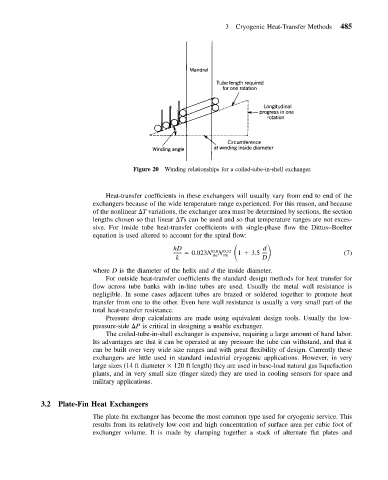Page 496 - Mechanical Engineers' Handbook (Volume 4)
P. 496
3 Cryogenic Heat-Transfer Methods 485
Figure 20 Winding relationships for a coiled-tube-in-shell exchanger.
Heat-transfer coefficients in these exchangers will usually vary from end to end of the
exchangers because of the wide temperature range experienced. For this reason, and because
of the nonlinear T variations, the exchanger area must be determined by sections, the section
lengths chosen so that linear Ts can be used and so that temperature ranges are not exces-
sive. For inside tube heat-transfer coefficients with single-phase flow the Dittus–Boelter
equation is used altered to account for the spiral flow:
0.023NN 1 3.5
hD 0.8 0.32 d (7)
k Re Pn D
where D is the diameter of the helix and d the inside diameter.
For outside heat-transfer coefficients the standard design methods for heat transfer for
flow across tube banks with in-line tubes are used. Usually the metal wall resistance is
negligible. In some cases adjacent tubes are brazed or soldered together to promote heat
transfer from one to the other. Even here wall resistance is usually a very small part of the
total heat-transfer resistance.
Pressure drop calculations are made using equivalent design tools. Usually the low-
pressure-side P is critical in designing a usable exchanger.
The coiled-tube-in-shell exchanger is expensive, requiring a large amount of hand labor.
Its advantages are that it can be operated at any pressure the tube can withstand, and that it
can be built over very wide size ranges and with great flexibility of design. Currently these
exchangers are little used in standard industrial cryogenic applications. However, in very
large sizes (14 ft diameter 120 ft length) they are used in base-load natural gas liquefaction
plants, and in very small size (finger sized) they are used in cooling sensors for space and
military applications.
3.2 Plate-Fin Heat Exchangers
The plate-fin exchanger has become the most common type used for cryogenic service. This
results from its relatively low cost and high concentration of surface area per cubic foot of
exchanger volume. It is made by clamping together a stack of alternate flat plates and

